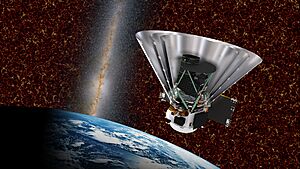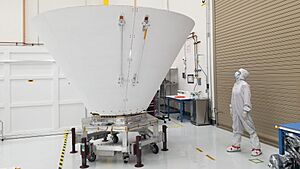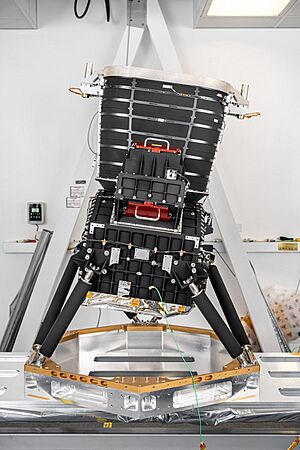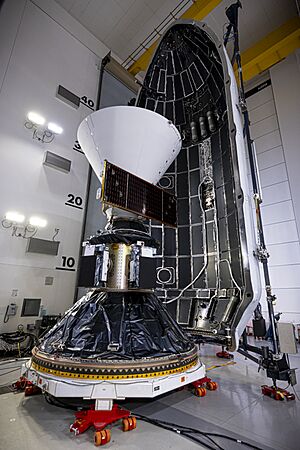SPHEREx facts for kids
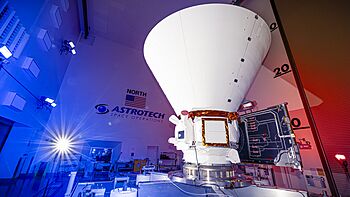
SPHEREx on a work stand, being prepared for launch
|
|
| Names | Spectro-Photometer for the History of the Universe, Epoch of Reionization, and Ices Explorer |
|---|---|
| Mission type | Astrophysics |
| Operator | NASA |
| Mission duration | Planned: 25 months Elapsed: 3 months, 27 days |
| Spacecraft properties | |
| Manufacturer | Ball Aerospace & Technologies |
| Launch mass | 178 kg (392 lb) |
| Start of mission | |
| Launch date | 12 March 2025, 03:10:00 UTC (11 March 2025, 8:10 pm PDT) |
| Rocket | Falcon 9 Block 5 |
| Launch site | Vandenberg, SLC-4E |
| Contractor | SpaceX |
| Orbital parameters | |
| Reference system | Geocentric orbit |
| Regime | Sun-synchronous, low Earth orbit |
| Altitude | 700 km (430 mi) |
| Inclination | 97° |
| Period | 90 minutes |
| Main telescope | |
| Diameter | 20 cm (7.9 in) |
| Wavelengths | Near-infrared |
|
Explorers Program
|
|
SPHEREx (which stands for Spectro-Photometer for the History of the Universe, Epoch of Reionization, and Ices Explorer) is a special space observatory. It looks at the universe using near-infrared light. Its main job is to map the entire sky and study about 450 million galaxies.
NASA chose SPHEREx in February 2019 for its next Medium-Class Explorers mission. It launched on March 11, 2025, on a Falcon 9 Block 5 rocket. The launch happened from Vandenberg Space Force Base. SPHEREx also carried some smaller satellites called PUNCH. The main scientist leading this project is James Bock from California Institute of Technology (Caltech).
Contents
Exploring the Universe with SPHEREx
What SPHEREx Will Do
SPHEREx uses a special tool called a spectrophotometer. This tool helps it measure near-infrared light across the whole sky. It will look at light from 0.75 to 5.0 micrometers. The mission will map the entire sky four times over 25 months. It uses 96 different color bands, which is much more detailed than older sky maps. A key part of its technology is a "linear variable filter."
SPHEREx will sort galaxies by their redshift. Redshift tells us how far away galaxies are and how fast they are moving away. It will categorize about 450 million galaxies. The mission will help scientists understand the early universe. It will look for clues about how the universe started and how galaxies formed. SPHEREx will also search for signs of water in other planetary systems.
This mission will work with other space telescopes like Euclid and the planned Nancy Grace Roman Space Telescope. SPHEREx will give precise distance information for nearby galaxies. This data, combined with measurements from Euclid and Nancy Grace Roman, will help map out dark matter. Dark matter is a mysterious substance that makes up a large part of the universe.
How SPHEREx Works
SPHEREx has a telescope with three mirrors. Its main opening is 20 centimeters wide. It can see a wide area of the sky. The telescope has six special cameras called photodetector arrays. These cameras are covered with a linear variable filter. This filter lets the telescope measure light at different wavelengths.
To get a full picture, SPHEREx takes many photos. It points itself to different spots in the sky. This way, it measures the same object at various wavelengths. Ball Aerospace & Technologies built the spacecraft and telescope. Caltech and NASA's Jet Propulsion Laboratory developed the science tools. A Korean institute helped by providing a special cold test chamber.
Mission History
The idea for SPHEREx was first suggested to NASA in December 2014. In July 2015, it was chosen for early development. This was part of the Small Explorer program. Later, an improved version of SPHEREx was suggested in December 2016. This time, it was for the Medium-Class Explorer (MIDEX) program.
In August 2017, SPHEREx became one of three finalists. The other two missions were Arcus and FINESSE. Each team received money to improve their mission plans. In February 2019, SPHEREx was chosen as the winner! This meant it could start being built and prepared for launch.
Medium-Class Explorer missions have a cost limit of US$250 million. This does not include the cost of the rocket. In April 2020, the total cost for SPHEREx was estimated to be around US$395 million to US$427 million. This estimate included the rocket and NASA's extra funds.
In January 2021, NASA announced that SPHEREx was moving to Phase C. This meant the design was approved, and teams could start building the hardware and software. The launch was expected between June 2024 and April 2025. On February 4, 2021, NASA announced that SpaceX's Falcon 9 rocket would launch SPHEREx. The launch cost was US$98.8 million. In August 2022, NASA decided that four small PUNCH satellites would also launch with SPHEREx. The mission successfully launched on March 11, 2025.
See also
 In Spanish: SPHEREx para niños
In Spanish: SPHEREx para niños


